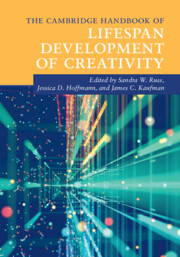Book contents
- The Cambridge Handbook of Lifespan Development of Creativity
- The Cambridge Handbook of Lifespan Development of Creativity
- Copyright page
- Dedication
- Contents
- Figures
- Tables
- Contributors
- Acknowledgments
- Introduction
- Part I Core Concepts of Lifespan Creativity Development
- Part II The Development of Creativity
- Part III Modes of Enhancement
- 12 Domain-Specific Talent Development
- 13 Enhancement of Creativity across the Lifespan in Mainland China
- 14 Beyond Flights of Fancy?
- 15 Creating Imaginary Worlds across the Lifespan
- 16 Imaginative Creativity in the Writing and Reading of Stories
- 17 The Effects of Video Games on Creativity
- Part IV Environments and Contexts
- Part V Special Populations
- Index
- References
12 - Domain-Specific Talent Development
from Part III - Modes of Enhancement
Published online by Cambridge University Press: 19 November 2021
- The Cambridge Handbook of Lifespan Development of Creativity
- The Cambridge Handbook of Lifespan Development of Creativity
- Copyright page
- Dedication
- Contents
- Figures
- Tables
- Contributors
- Acknowledgments
- Introduction
- Part I Core Concepts of Lifespan Creativity Development
- Part II The Development of Creativity
- Part III Modes of Enhancement
- 12 Domain-Specific Talent Development
- 13 Enhancement of Creativity across the Lifespan in Mainland China
- 14 Beyond Flights of Fancy?
- 15 Creating Imaginary Worlds across the Lifespan
- 16 Imaginative Creativity in the Writing and Reading of Stories
- 17 The Effects of Video Games on Creativity
- Part IV Environments and Contexts
- Part V Special Populations
- Index
- References
Summary
The development of creativity is simultaneously possible and impossible. It is impossible because creativity is very domain specific, which means there is no general, all-purpose creative-thinking skill or set of skills that is applicable across domains. Just as there is no such thing as domain-general expertise – one can be an expert in one or many domains, but one cannot be an all-purpose expert in all domains – there is no domain-general creativity. There being no such domain-general skills, there are no domain-general creativity-relevant skills to be nurtured. On the other hand, the nurturance of creativity domain by domain is quite possible. This chapter explores the issue of how domain specificity affects the development of creativity.
- Type
- Chapter
- Information
- The Cambridge Handbook of Lifespan Development of Creativity , pp. 265 - 277Publisher: Cambridge University PressPrint publication year: 2021

